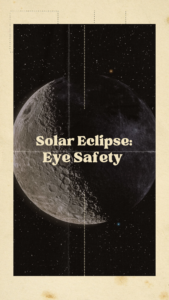Solar Eclipse – Eye Safety
 Thank you to the physicians at Children’s National Medical Center for providing these great tips for enjoying the upcoming solar eclipse safely.
Thank you to the physicians at Children’s National Medical Center for providing these great tips for enjoying the upcoming solar eclipse safely.
Eye Safety for Viewing a Solar Eclipse
On August 21, 2017, there will be a solar eclipse. People across the United States will fall under the path of this rare solar eclipse, and depending on their location, may witness a total solar eclipse. Eye safety is very important when viewing a solar eclipse. Without safe viewing and appropriate eye protection, permanent eye damage can occur. Eye experts at Children’s National have provided some vital information on what you can expect to see and how to view the eclipse safely.
What will I see during the eclipse?
During a total eclipse, the sun will gradually disappear behind the moon then reappear. The sun’s outer “corona” will be visible at this time. Depending on your location, a partial eclipse will be seen, which is when the moon covers a portion of the sun.
How long will the eclipse last?
The whole continent will experience a partial eclipse event, lasting 2 to 3 hours in which the moon will cover part of the sun. The total solar eclipse only lasts 2 to 3 minutes and can be seen within a 70-mile wide path from Oregon to South Carolina. The moon will completely block the view of the sun in this pathway.
How can the eye be damaged by viewing a solar eclipse?
The lenses in your eyes act like a magnifying glass, one that is 5 times more powerful than a handheld magnifier. Think about how you can use that typical handheld magnifier to focus the sun to burn holes in paper. That’s what happens when you look at the sun without appropriate eye protection. You focus the sun’s light on the retina, burning holes in light-sensitive photoreceptor cells, 5 times faster, and causing permanent blindness. Watching a partially eclipsed sun is when the damage occurs.
Do I need special equipment to view an eclipse?
Yes! Please be sure to follow these steps to protect your eyes from the partial eclipse:
- Anyone planning to view the eclipse should wear a pair of solar viewing glasses or handheld solar viewers that contain solar filters. Always supervise children using solar viewing glasses or viewers with solar filters.
- Using protective eyewear will allow observers to look directly at the sun during the eclipse. Sunglasses should not be used in place of solar viewing glasses– they will not protect your eyes from damage. Homemade filters are also not safe to use to look at the sun.
- Always inspect your solar filter before you use it – if it is scratched or damaged in any way, do not use it.
- Do not look at a partially eclipsed sun through an unfiltered camera, binoculars or telescope – even if you are wearing solar viewing glasses. A special filter is required to view without damage to your eyes.
Remember – no matter where you are to observe the eclipse, looking directly at the sun, especially when it is partially covered by the moon, can cause serious eye damage or even blindness.
What else should I know before viewing the eclipse?
Remember to be safe and enjoy this fascinating event! For more information you can visit the web site of the American Astronomical Society or the American Academy of Ophthalmology.


